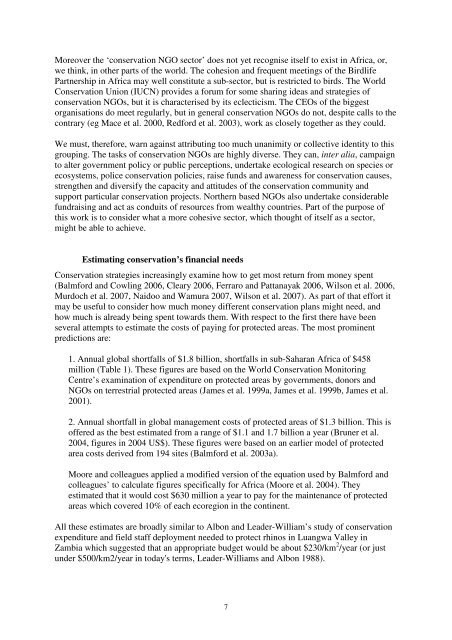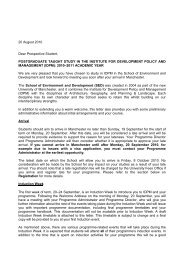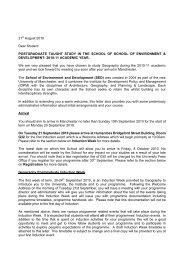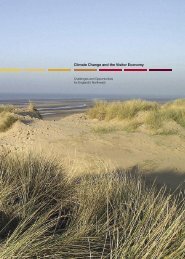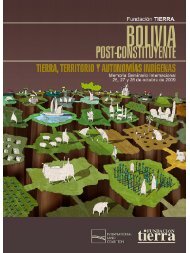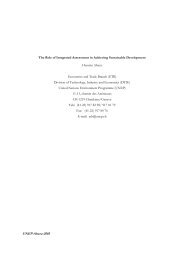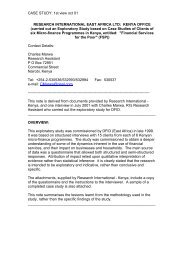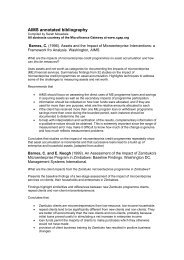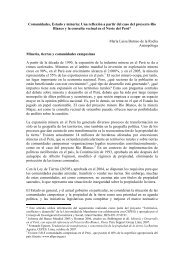Non Governmental Organisations and African Wildlife Conservation ...
Non Governmental Organisations and African Wildlife Conservation ...
Non Governmental Organisations and African Wildlife Conservation ...
You also want an ePaper? Increase the reach of your titles
YUMPU automatically turns print PDFs into web optimized ePapers that Google loves.
Moreover the ‘conservation NGO sector’ does not yet recognise itself to exist in Africa, or,<br />
we think, in other parts of the world. The cohesion <strong>and</strong> frequent meetings of the Birdlife<br />
Partnership in Africa may well constitute a sub-sector, but is restricted to birds. The World<br />
<strong>Conservation</strong> Union (IUCN) provides a forum for some sharing ideas <strong>and</strong> strategies of<br />
conservation NGOs, but it is characterised by its eclecticism. The CEOs of the biggest<br />
organisations do meet regularly, but in general conservation NGOs do not, despite calls to the<br />
contrary (eg Mace et al. 2000, Redford et al. 2003), work as closely together as they could.<br />
We must, therefore, warn against attributing too much unanimity or collective identity to this<br />
grouping. The tasks of conservation NGOs are highly diverse. They can, inter alia, campaign<br />
to alter government policy or public perceptions, undertake ecological research on species or<br />
ecosystems, police conservation policies, raise funds <strong>and</strong> awareness for conservation causes,<br />
strengthen <strong>and</strong> diversify the capacity <strong>and</strong> attitudes of the conservation community <strong>and</strong><br />
support particular conservation projects. Northern based NGOs also undertake considerable<br />
fundraising <strong>and</strong> act as conduits of resources from wealthy countries. Part of the purpose of<br />
this work is to consider what a more cohesive sector, which thought of itself as a sector,<br />
might be able to achieve.<br />
Estimating conservation’s financial needs<br />
<strong>Conservation</strong> strategies increasingly examine how to get most return from money spent<br />
(Balmford <strong>and</strong> Cowling 2006, Cleary 2006, Ferraro <strong>and</strong> Pattanayak 2006, Wilson et al. 2006,<br />
Murdoch et al. 2007, Naidoo <strong>and</strong> Wamura 2007, Wilson et al. 2007). As part of that effort it<br />
may be useful to consider how much money different conservation plans might need, <strong>and</strong><br />
how much is already being spent towards them. With respect to the first there have been<br />
several attempts to estimate the costs of paying for protected areas. The most prominent<br />
predictions are:<br />
1. Annual global shortfalls of $1.8 billion, shortfalls in sub-Saharan Africa of $458<br />
million (Table 1). These figures are based on the World <strong>Conservation</strong> Monitoring<br />
Centre’s examination of expenditure on protected areas by governments, donors <strong>and</strong><br />
NGOs on terrestrial protected areas (James et al. 1999a, James et al. 1999b, James et al.<br />
2001).<br />
2. Annual shortfall in global management costs of protected areas of $1.3 billion. This is<br />
offered as the best estimated from a range of $1.1 <strong>and</strong> 1.7 billion a year (Bruner et al.<br />
2004, figures in 2004 US$). These figures were based on an earlier model of protected<br />
area costs derived from 194 sites (Balmford et al. 2003a).<br />
Moore <strong>and</strong> colleagues applied a modified version of the equation used by Balmford <strong>and</strong><br />
colleagues’ to calculate figures specifically for Africa (Moore et al. 2004). They<br />
estimated that it would cost $630 million a year to pay for the maintenance of protected<br />
areas which covered 10% of each ecoregion in the continent.<br />
All these estimates are broadly similar to Albon <strong>and</strong> Leader-William’s study of conservation<br />
expenditure <strong>and</strong> field staff deployment needed to protect rhinos in Luangwa Valley in<br />
Zambia which suggested that an appropriate budget would be about $230/km 2 /year (or just<br />
under $500/km2/year in today's terms, Leader-Williams <strong>and</strong> Albon 1988).<br />
7


